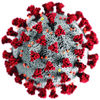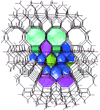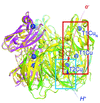issue contents
May 2020 issue

editorial
BIOLOGY | MEDICINE
Crystallography in its broadest sense has a crucial role to play in addressing the current COVID-19 pandemic. An outpouring of structural information on key viral proteins has resulted and importantly these data have immediately been shared with researchers round the world to speed the discovery of effective therapeutic agents.
scientific commentaries
CHEMISTRY | CRYSTENG
Quasicrystals (QCs) are unique materials, whose crystallographic identity has been controversial for many years. Using recent advances in shock synthesis, Hu et al. [(2020), IUCrJ, 7, 434–444] reproduce for the first time the formation conditions of the icosahedral Al62Cu31Fe7 QC (i-phase II) found in the Khatyrka meteorite. The authors demonstrate that shock-recovery experiments provide a novel strategy for preparing and exploring QCs.
research letters
NEUTRON | SYNCHROTRON
Download citation


Download citation


Strong hydrogen bonding in a dense hydrous magnesium silicate discovered by neutron Laue diffraction
By using neutron Laue diffraction, strong hydrogen bonding was observed in the framework structure of phase E of dense hydrous magnesium silicate. Such bonding plays a crucial role in stabilizing large amounts of hydrogen in the crystal structures of minerals under high-pressure and high-temperature conditions inside deep Earth.
CCDC reference: 1990294
BIOLOGY | MEDICINE
The structural characterization of the NS3-like helicase of a segmented virus from the Flaviviridae is reported.
PDB reference: NS3-like helicase from Alongshan virus, 6m40
research papers
NEUTRON | SYNCHROTRON
Download citation


Download citation


A successful feasibility study of experimental electron density in the mineral grossular under 1 GPa pressure was conducted at the CRISTAL beamline at the SOLEIL synchrotron. Such studies allow for laboratory simulations of processes that take place in the Earth's mantle.
BIOLOGY | MEDICINE
The validity of the dose-fractionation theorem and the dependence of required dose on object size and resolution are analysed for various types of X-ray imaging, including coherent-, incoherent- and absorption-based methods. Estimates are given for the achievable resolutions for cells and other soft biological material.
CRYO | EM
X-ray crystallographic and cryo-EM structural analyses have been performed on the same chromatographic fraction of quinol-dependent nitric oxide reductase from Neisseria meningitidis to high resolution. This represents one of the first examples in which the two approaches have been used to reveal a monomeric assembly in the crystal and a dimeric assembly in the frozen cryo-EM solution. A number of factors have been identified that may trigger the destabilization of the helices that are necessary to preserve the integrity of the dimer.
CRYO | EM
Transient temperature differences between the grid and support foil during cooling may generate compressive stresses in the sample that drive the observed beam-induced doming motion.
CHEMISTRY | CRYSTENG
Download citation


Download citation


The relationships and distinctions among a series of diacids in polymorphic outcomes and solid/solution chemistry were utilized to reveal the conformational polymorph nucleation pathway: difficulty in desolvation has a remarkable effect on the result of rearrangement and nucleation outcome.
CHEMISTRY | CRYSTENG
The icosahedral quasicrystal with unique composition Al62Cu31Fe7, from the Khatyrka meteorite, is the only quasicrystalline phase ever discovered in nature prior to being synthesized in a laboratory. This study reproduces this icosahedral phase for the first time using a shock-recovery experiment, proving the planetary impact origin of natural quasicrystals.
CRYO | EM
The beam-image shift method accelerates data acquisition in cryo-EM single-particle reconstruction by rapid repositioning of the imaging area, but at the cost of more complex optical aberrations when the shifts are large, even when the coma is compensated for by beam tilt.
CRYO | EM
A few successful drugs are available against malaria, but the magnitude of the impact caused by this disease requires additional measures for successful treatment and the goal of eradication. Here, new information is presented on hexokinase, a key protein in the infection process that represents a promising target for therapeutic intervention.
BIOLOGY | MEDICINE
The relationship between GTP binding and hydrolysis on the one hand and septin filament assembly and function on the other has yet to be fully elucidated. The crystal structures of SEPT3 subgroup members bound to either GDP or to a GTP analogue shed light on this question by indicating how the squeezing of one of the inter-subunit interfaces may lead to the exposure of a polybasic region important for membrane association.
MATERIALS | COMPUTATION
Stereochemically active lone pairs are an important non-bonding effect with significant implications on crystal structure and physical properties. This work reveals the highly repulsive nature of interactions between stereochemically active lone pairs, and shows how cooperative effects lead to stronger expression of stereochemically active lone pairs, affecting their impact on thermal conductivity.
CRYO | EM
This article demonstrates how a nano-focused electron beam can be used to collect sparse diffraction patterns from ∼40 nm regions of a macromolecular crystal that are subsequently digitally recombined into a tilt series suitable for ab initio phasing. By synthesizing signals from specific sub-regions of a crystal after data are collected, the findings provide the basis for capturing atomic level information from mosaic or partially ordered crystals that might otherwise be overlooked.
PDB references: NanoEDT structure of OsPYL/RCAR5 (24–29), 6uop; Structure of OsPYL/RCAR5 (24–29) using discrete-angle tilt series, 6uoq; MicroED structure of OsPYL/RCAR5 (24–29) at 3 e− Å2, 6uor; MicroED structure of OsPYL/RCAR5 (24–29) at 6 e− Å2, 6uos; MicroED structure of OsPYL/RCAR5 (24–29) at 9 e− Å2, 6uou; MicroED structure of OsPYL/RCAR5 (24–29) at 12 e− Å2, 6uow
BIOLOGY | MEDICINE
Protein crystals exposed to a scanning electron microscope beam were analysed using X-ray diffraction to assess the impact of electrons on crystal quality. These experiments support the use of a scanning electron microscope as an imaging tool for locating and centring microcrystals with a view to implement this technology on the VMXm beamline at Diamond Light Source.
BIOLOGY | MEDICINE
The crystal structure of SAV0491, a TatD-related DNase from the Gram-positive bacterium Staphylococcus aureus, was determined at 1.85 Å resolution, providing functional and structural insights into a putative DNA-binding mode of SAV0491.
PDB reference: TatD, 6l25
MATERIALS | COMPUTATION
Download citation


Download citation


RUB-5 and its related hydrous layer silicate RUB-6 were synthesized in the 1990s, but so far their structures have remained unknown due to their low crystallinity and disorder. The combination of 3D electron diffraction, X-ray powder diffraction, high-resolution transmission electron microscopy, structural modelling and diffraction simulations has enabled a comprehensive description of these two nanomaterials, revealng a new framework topology and a unique silica polymorph.
PHYSICS | FELS
A new kind of phasonic entropy-stabilized decagonal quasicrystal (space group P10/mmm) was observed in the Zn–Mg–Y system, in addition to an icosahedral quasicrystal and a decagonal quasicrystal (space group P105/mmc) which have been reported previously. This decagonal quasicrystal can be modeled with dense packing of icosahedrons at vertices of fat rhombic and flattened hexagonal tiles.
CHEMISTRY | CRYSTENG
The results presented in this work give new insights into the molecular mechanism of crystallization nucleation for conformational polymorphic systems. It can be used to regulate conformational polymorphism.
BIOLOGY | MEDICINE
Tethered protein–protein complexes are presumed to offer functional advantages such as electron transfer due to constraints imposed on the conformational search. This work shows that tethering has a much more complex role.
CRYO | EM
A new method for accurate real-time defocus modulation in electron microscopy that will improve the configurability of the technique is presented.



 journal menu
journal menu




 access
access


































